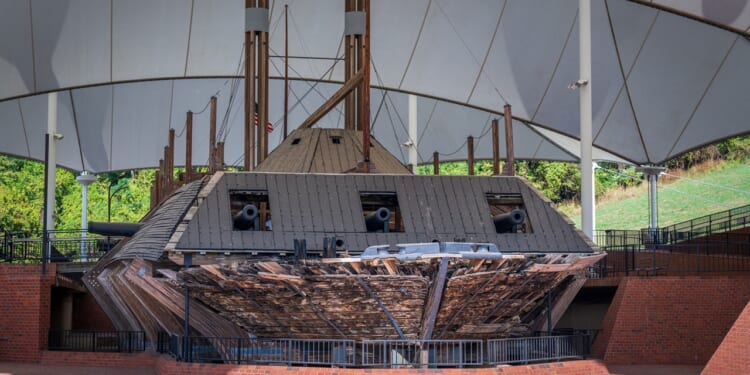The USS Cairo, a Civil War-era “ironclad” gunboat, was raised from the Mississippi River in 1964—but if its wood decay problem goes unaddressed, it may sink again.
One of America’s oldest partially-preserved warships is in danger of losing a fight, and efforts are now underway to save it. The threat isn’t from a foreign adversary, but rather fungi, which are slowly but continuously degrading the USS Cairo, one of seven shallow-draft City-class river ironclads that saw service during the Civil War.
The warship—which has the distinction of being the first armored vessel sunk by an electronically detonated torpedo—is the “star attraction” at Vicksburg National Military Park, Mississippi.
Launched in January 1862, USS Cairo initially was operated by the United States Army, specifically the Union Army’s Western Gunboat Flotilla. The steam-powered ironclad, armed with 13 guns, was designed to help the Union forces gain control of the Mississippi River and cut the Confederacy in half. Her service was brief, with only limited combat actions, before she was sunk by the remotely detonated torpedo while operating in the Yazoo River, approximately seven miles north of Vicksburg.
That was the end of the ironclad’s military career, and it could have been the end of the story. However, more than a century later, in 1964, the state of Mississippi funded the raising of the Cairo. In 1972, by an act of Congress, she was transferred to the National Park Service (NPS), which reassembled the remnants and put the vessel on display.
Museum Ships Often Face Environmental Threats
Several significantly historic United States Navy warships are preserved as floating museums. These include the USS Constitution, one of the original six frigates authorized by Congress in 1794; all four Iowa-class battleships that served in the Second World War; and the USS Texas (BB-35), the only surviving battleship to serve in both World Wars.
Time and the elements have often been these vessels’ greatest foes, and great effort (and great expense) has been taken to restore and maintain them.
USS New Jersey (BB-62) underwent a more than three-month-long period in dry dock in 2024 that saw the battleship receive a new paint job to her hull as part of a $10 million revitalization effort, and more than 300,000 man-hours have gone into refurbishing USS Texas, the first major maintenance the battleship had seen in a generation. BB-35 is now set to head to her new home in Galveston, Texas, in 2026.
Can the USS Cairo Be Saved?
The situation with the USS Cairo may be even more serious.
Since 1977, the Civil War ironclad has been partially preserved on a concrete base near the Vicksburg National Cemetery, protected only by a fabric canopy.
Considering that a torpedo had sunk the vessel and she then spent more than 100 years underwater, the ironclad was relatively well-preserved, but researchers recently identified a new threat. Soft-rot and white-rot fungi are present throughout the wooden hull, and researchers warned that the fungi may be tolerant of wood preservation treatments and other chemicals applied to maintain the vessel’s structural integrity.
“Finding so many fungi that cause wood decay alive in the ship timbers was a surprise,” explained Robert “Bob” Blanchette, a professor of plant pathology at the University of Minnesota, and lead author of a new study on the condition of USS Cairo.
The study, supported by the USDA Hatch Project and the NPS, was published in the Journal of Fungi. It recommended that the ironclad be moved to an indoor, climate-controlled space. Currently, the Civil War ironclad sits beneath its canopy, where it is exposed to high humidity and summer heat.
“An enclosed structure would also prevent dust, insects, and animals from interacting with the ship. Undoubtedly, the condition of the wood will continue to deteriorate if the existing biodeterioration and biodegradation processes underway in the ship are left unaddressed,” the study explained.
Keeping the warship in its present location jeopardizes its future.
“The wood surfaces are decayed and many of the timbers have had their strength properties compromised—but many of the timbers are large and thick and still have moderately good integrity,” Blanchette wrote in an email to the Civil War Picket blog. “However, the presence of active decay fungi indicates they are progressively causing additional decay.”
Such research into the microbial degradation of historic woods is “essential to help protect and preserve important cultural artifacts,” Phys.org reported. But the findings are already conclusive: The longer USS Cairo remains outside, the faster the fungi will continue to spread through the hull, and in time, nothing will be left of the ironclad.
About the Author: Peter Suciu
Peter Suciu has contributed over 3,200 published pieces to more than four dozen magazines and websites over a 30-year career in journalism. He regularly writes about military hardware, firearms history, cybersecurity, politics, and international affairs. Peter is also a contributing writer for Forbes and Clearance Jobs. He is based in Michigan. You can follow him on Twitter: @PeterSuciu. You can email the author: [email protected].
Image: Shutterstock / Steve Heap.


















